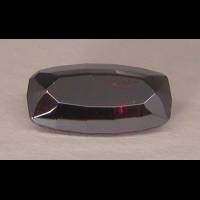Pyrargyrite

Bolivia
0.94 carats
© Rarestone.com
Pyrargyrite forms translucent deep red prismatic crystals with adamantine lustre. The material can be very attractive but it may darken on exposure to light.
Transparent crytals of facet-grade are rare.
Pyrargyrite Gemstones by Colour
This table shows the variety of hues this gemstone can be found in. Click on a photo for more information.
Pyrargyrite Gemstones by Size
This table shows distribution of Pyrargyrite gemstone sizes that are listed on this site. This can give a good indication as to the general availability of this gemstone in different sizes.
Contributed photos
Lightest:0.94 cts
Heaviest:12.83 cts
Average:6.88 cts
Total photos:2
Do you have a larger Pyrargyrite? Why not upload a photo?
| General Information | |||||||||||||||||
|---|---|---|---|---|---|---|---|---|---|---|---|---|---|---|---|---|---|
| Chemical Formula |
| ||||||||||||||||
| Physical Properties of Pyrargyrite | |||||||||||||||||
| Mohs Hardness | 2.5 to 3, Gemmological Tables (2004) More from other references | ||||||||||||||||
| Specific Gravity | 5.85, Gemmological Tables (2004) More from other references | ||||||||||||||||
| Tenacity | Brittle, Handbook of Mineralogy (2001) | ||||||||||||||||
| Cleavage Quality | Indistinct, Gemstones (2009) More from other references | ||||||||||||||||
| Fracture | Conchoidal, Gemstones (2009) More from other references | ||||||||||||||||
| Light Sensitivity | May darken on exposure to light, Gems, Sixth Edition (2006) More from other references | ||||||||||||||||
| Optical Properties of Pyrargyrite | |||||||||||||||||
| Refractive Index | 2.881 to 3.084, Gemmological Tables (2004) More from other references | ||||||||||||||||
| Optical Character | Uniaxial/-, Gemmological Tables (2004) More from other references | ||||||||||||||||
| Birefringence | 0.203, Gemmological Tables (2004) More from other references | ||||||||||||||||
| Pleochroism | Strong, Gemstones (2009) More from other references | ||||||||||||||||
| Dispersion | Strong, Gemstones (2009) | ||||||||||||||||
| Colour | |||||||||||||||||
| Colour (General) | Gray, black, red, Gemmological Tables (2004) More from other references | ||||||||||||||||
| Transparency | Translucent,Opaque, Gemmological Tables (2004) Seldom transparentMore from other references | ||||||||||||||||
| Lustre | Adamantine, Gems, Sixth Edition (2006) More from other references | ||||||||||||||||
| Crystallography of Pyrargyrite | |||||||||||||||||
| Crystal System | Trigonal, Gemmological Tables (2004) More from other references | ||||||||||||||||
| Habit | Prismatic, Gems, Sixth Edition (2006) More from other references | ||||||||||||||||
| Geological Environment | |||||||||||||||||
| Where found: | Pyrargyrite occurs in hydrothermal veins as a primary late-stage low-temperature mineral., Gems, Sixth Edition (2006) | ||||||||||||||||
| Further Information | |||||||||||||||||
| Mineral information: | Pyrargyrite information at mindat.org | ||||||||||||||||
| Significant Gem Localities | |||||||||||||||||
| |||||||||||||||||

